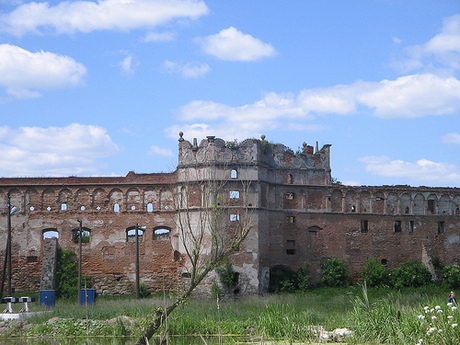Stare Selo
Stare selo (Old village) is really very old as its castle is the oldest in Lviv region. First memory about this village is dated back to the XIV century and the main reason why we can still observe the castle is that it has been rebuilt many times after the enemies invasions. Now there are only ruins of the castle left.
Stare Selo has very ancient history originated from the period of The Old Russ. The name Stare Selo is mentioned since 1454. In 1642 in the village the princes Ostrozkiy and Zaslavskiy founded the castle-fortress, which was destroyed completely by Bogdan Khmelnytskiy troops in 1648. Not far away on the hill there are two big lime stumps, according to the stories they keeps the memories about the Tatar chief, killed on this place from the Castle.
Its original timber fortifications, first mentioned in 1448, were destroyed by the invading Turks in the late 15th century. A more secure stone fort, intended to defend the Barlad Road from Lviv to Romania, was built in Stare Selo in the 1580s. Those walls were breached and rendered useless by Khmelnytsky's Cossacks during the Siege of Lviv in 1648.
There is a chapel, palace and utility rooms in the castle’s court yard. We learned out from the documents that in XVII c. there were 8 cannons, a lot of guns and cold arms in the Castle. The Silent Giant remembers the military battles and big parties, and times of the Arsenal opened within the walls of the Castle. During the centuries the Castle used to be a winery, warehouse and even brewery.
Stare Selo is a village in Pustomyty Raion, Lviv Oblast, Ukraine known as the site of a large castle, or rather fortress, of Princes Ostrogski. Its original timber fortifications, first mentioned in 1448, were destroyed by the invading Turks in the late 15th century. A more secure stone fort, intended to defend the Bârlad Road from Lviv to Romania, was built in Stare Selo in the 1580s. Those walls were breached and rendered useless by Khmelnytsky's Cossacks during the Siege of Lviv in 1648.
Ruthenian Prince Vladislav Dominik Zaslavski-Ostrogski began to build a fortress here in 1642. The fortress was destroyed in 1648 before it was even finished by the Cossack forces of Bogdan Khmelnitsky as they laid siege to Lviv. Dominik shamefully escaped when he heard the approaching Cossacks and received the nickname "feather-bed" from Khmelnitsky. "Feather-bed" finally completed the fortress from ruins in 1654 just in time for Khmelnitsky's second attack. This time Dominik held his ground and defeated the Cossack detachment sent against him. The castle then withstood the Turkish invasion of 1672. The great families of Poland and Lithuania – Radzivill, Sieniawski, Czartoryskyi, and Potocki – each owned the castle in turn. The most important were the Sieniawski family who at the beginning of the 18th century restored the fortress and brought there from Lviv, before the assault of the Swedes, their arsenal. The castle began to fall under decay when the Czartoryskyi family starting in 1731 owned it due to family ties. In the 19th century the Potocki family built a brewery and distillery on the property that furthered damaged the fortress that now lies in ruin.
The existing fortress, almost triangular in shape, with 15-metre high walls and a ceremonial gate on the south side, was commissioned by Prince Władysław Dominik Zasławski, one of the last members of the Ostrogski family. The citadel was erected in 1649-54 and formerly contained the palatial residence of Prince Zaslawski, one of the richest landowners of Eastern Europe and brother-in-law of King John III Sobieski. After Prince Zaslawski died in Stare Selo in 1656, the fortress gradually fell into disrepair, although it successfully withstood a siege by the Turks in 1674.
Each year there is a music festival held in Stare Selo. The village is very popular bicycle-travel destination and historical sight. To get there you must first take a flight to Lviv. Stare Seo is some 30 km away from the city. It offers quietness, great landscapes and interesting events.




